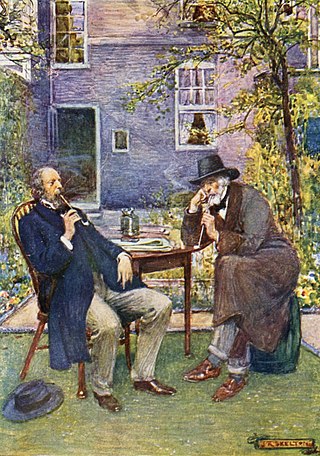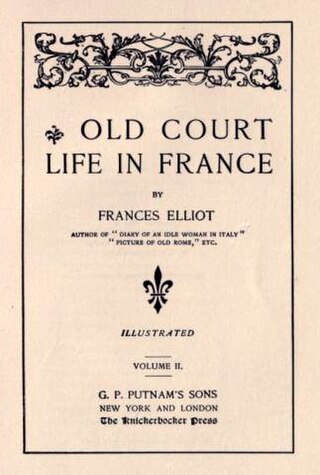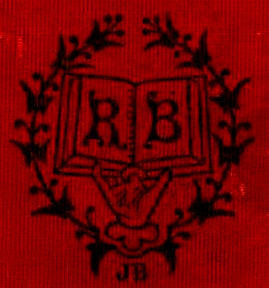
Louisa May Alcott was an American novelist, short story writer, and poet best known for writing the novel Little Women (1868) and its sequels Good Wives (1869), Little Men (1871) and Jo's Boys (1886). Raised in New England by her transcendentalist parents, Abigail May and Amos Bronson Alcott, she grew up among many well-known intellectuals of the day, including Margaret Fuller, Ralph Waldo Emerson, Nathaniel Hawthorne, Henry David Thoreau, and Henry Wadsworth Longfellow.

Little Women is a coming-of-age novel written by American novelist Louisa May Alcott, originally published in two volumes in 1868 and 1869. The story follows the lives of the four March sisters—Meg, Jo, Beth, and Amy—and details their passage from childhood to womanhood. Loosely based on the lives of the author and her three sisters, it is classified as an autobiographical or semi-autobiographical novel.

Charlotte Mary Yonge was an English novelist, who wrote in the service of the church. Her abundant books helped to spread the influence of the Oxford Movement and show her keen interest in matters of public health and sanitation.

This article contains information about the literary events and publications of 1873.
Events from the year 1868 in literature .
This article contains information about the literary events and publications of 1853.
John Andrew Sutherland is a British academic, newspaper columnist and author. He is Emeritus Lord Northcliffe Professor of Modern English Literature at University College London.

Juliana Horatia Ewing was an English writer of children's stories. Her writings display a sympathetic insight into children's lives, an admiration for things military, and a strong religious faith.

Tauchnitz was the name of a family of German printers and publishers. They published English language literature for distribution on the European continent outside Great Britain, including initial serial publications of novels by Charles Dickens. Though copyright protection did not exist between nations in the 19th century, Tauchnitz paid the authors for the works they published, and agreed to limit their sales of English-language books to the European continent, as authors like Dickens or Bulwer-Lytton had separate arrangements for publication and sale in Great Britain.
Mabel is an English female name derived from the Latin amabilis, "lovable, dear".

Victorian literature is English literature during the reign of Queen Victoria (1837–1901). The 19th century is considered by some to be the Golden Age of English Literature, especially for British novels. It was in the Victorian era that the novel became the leading literary genre in English. English writing from this era reflects the major transformations in most aspects of English life, from scientific, economic, and technological advances to changes in class structures and the role of religion in society. The number of new novels published each year increased from 100 at the start of the period to 1000 by the end of it. Famous novelists from this period include Charles Dickens, William Makepeace Thackeray, the three Brontë sisters, Elizabeth Gaskell, George Eliot, Thomas Hardy, and Rudyard Kipling.

Jo's Boys, and How They Turned Out: A Sequel to "Little Men" is a novel by American author Louisa May Alcott, first published in 1886. The novel is the final book in the unofficial Little Women series. In it, the March sisters' children and the original students of Plumfield, now grown, are caught up in real world troubles as they work towards careers and pursue love.
The Romantic hero is a literary archetype referring to a character that rejects established norms and conventions, has been rejected by society, and has themselves at the center of their own existence. The Romantic hero is often the protagonist in a literary work, and the primary focus is on the character's thoughts rather than their actions.

A Long Fatal Love Chase is a 1866 novel by Louisa May Alcott published posthumously in 1995. Two years before the publication of Little Women, Alcott uncharacteristically experimented with the style of the thriller and submitted the result, A Long Fatal Love Chase, to her publisher. The manuscript was rejected, and it remained unpublished before being bought, restored and published to acclaim in 1995.
Events from the year 1853 in the United Kingdom.

Frances Minto Elliot (1820–1898) was a prolific English writer, primarily of non-fiction works on the social history of Italy, Spain, and France and travelogues. She also wrote three novels and published art criticism and gossipy, sometimes scandalous, sketches for The Art Journal, Bentley's Miscellany, and The New Monthly Magazine, often under the pseudonym, "Florentia". Largely forgotten now, she was very popular in her day, with multiple re-printings of her books in both Europe and the United States. Elliot had a wide circle of literary friends including Charles Dickens, Anthony Trollope and Wilkie Collins. Collins dedicated his 1872 novel, Poor Miss Finch, to her, and much of the content in Marian Holcolmbe's conversations in The Woman in White is said to be based on her.

The Adventures of Philip on his Way Through the World: Shewing Who Robbed Him, Who Helped Him, and Who Passed Him By is the final novel by the English author William Makepeace Thackeray, originally published in 1861–1862. It was the last novel Thackeray completed, and harks back to several of his previous ones, involving as it does characters from A Shabby Genteel Story and being, like The Newcomes, narrated by the title character of his Pendennis. In recent years it has not found as much favour from either readers or critics as Thackeray's early novels.

Messrs. Roberts Brothers (1857–1898) were bookbinders and publishers in 19th-century Boston, Massachusetts. Established in 1857 by Austin J. Roberts, John F. Roberts, and Lewis A. Roberts, the firm began publishing around the early 1860s. American authors included: Louisa May Alcott, Susan Coolidge, Emily Dickinson, Maud Howe Elliott, Louise Imogen Guiney, Julia Ward Howe, Helen Hunt Jackson, Abigail May Alcott Nieriker. British and European authors included: Berthold Auerbach, Caroline Bauer, Mathilde Blind, Juliana Horatia Ewing, Anne Gilchrist, David Gray, Philip Gilbert Hamerton, Jean Ingelow, Vernon Lee, William Morris, Silvio Pellico, Adelaide Ristori, A. Mary F. Robinson, George Sand, Charlotte Mary Yonge, Helen Zimmern.

Lady Amabel Frederica Henrietta Kerr was a British aristocrat and writer of religious literature, biographies, children's literature, and novels. She was also a translator from German to English, and a magazine editor. She was described in the University of Ottawa Review as "a rare example of strenuous devotion to the service of God and His Church, rendered all the more forcible by reason of the obscurity in which she endeavored to shroud her work". Kerr was the author of a number of books, among them: Unravelled Convictions, being the reasons for her conversion; Before Our Lord Came, an Old Testament history for little children; A Mixed Marriage, a novel; Life of Joan of Arc, and Life of Blessed Sebastian Valfre. She died in October 1906.













